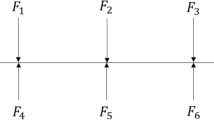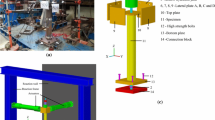Abstract
Cross-sectional ovalization of thin-walled circular steel tube because of large plastic bending, also known as the Brazier effect, usually occurs during the initial stage of tube′s continuous rotary straightening process. The amount of ovalization, defined as maximal cross section flattening, is an important technical parameter in tube′s straightening process to control tube′s bending deformation and prevent buckling. However, for the lack of special analytical model, the maximal section flattening was determined in accordance with the specified charts developed by experienced operators on the basis of experimental data; thus, it was inevitable that the localized buckling might occur during some actual straightening operations. New normal strain component formulas were derived based on the thin shell theory. Then, strain energy of thin-walled tube (per unit length) was obtained using the elastic-plastic theory. A rational model for predicting the maximal section flattening of the thin-walled circular steel tube under its straightening process was presented by the principle of minimum potential energy. The new model was validated by experiments and numerical simulations. The results show that the new model agrees well with the experiments and the numerical simulations with error of less than 10%. This new model was expected to find its potential application in thin-walled steel tube straightening machine design.
Similar content being viewed by others
Abbreviations
- A ϕ :
-
Circumferential Lame parameter of middle surface
- E :
-
Modulus of elasticity
- E 1 :
-
Plastic strain-hardening coefficient
- E′:
-
Plastic modulus
- R w :
-
Radius of curvature of deformed tube′s neutral axis (bending radius)
- R wp :
-
Axial radius of curvature at an arbitrary point on middle surface
- Rϕ, Rθ:
-
Circumferential and radial radii of principal curvature
- r :
-
Initial radius of tube cross section
- u(z), w(z):
-
Circumferential and radial displacements acting on a surface with a distance z from middle surface
- v, u, w :
-
Axial, circumferential and radial displacements acting on middle surface
- z :
-
Distance from middle surface of shell
- Δ1, Δ2:
-
Increases of the arc segment PQ owing to circumferential displacement and radial displacement
- δ:
-
Half of maximum flattening
- δa:
-
Maximum flattening throughout tube′s cross section
- δlim:
-
Allowable flattening
- εϕ, εθ:
-
Circumferential and radial strain components acting on middle surface
- \(\varepsilon _\phi ^{(z)},\varepsilon _\theta ^{(z)}\) :
-
Circumferential and radial strain components acting on an arbitrary revolution surface at a radial distance z from middle surface
- \(\bar \varepsilon \) :
-
Effective strain
- ζj, ηj:
-
Dimensionless unknown coefficients
- θ:
-
Central angle of deformed tube
- vi, μi:
-
Quantities defined to simplify the expressions
- ∏ :
-
Internal plastic strain energy per unit length tube
- \(\bar \sigma \) :
-
Effective stress
- σs:
-
Yield stress
- \(\sigma _\phi ^{(z)},\sigma _\theta ^{(z)}\) :
-
Circumferential and radial stress components acting on an arbitrary revolution surface at a radial distance z from middle surface
- ϕ:
-
Central angle between point P and the major axis.
References
A. Mutrux, B. Berisha, P. Horan, J. Mater. Process. Technol. 211 (2011) 1448–1456.
Z. Q. Zhang, Y. H. Yan, H. L. Yang, Chin. J. Mech. Eng. 49 (2013) No. 11, 160–168.
L. G. Brazier, Proc. R. Soc. Lond. A -Math. Phy. 116 (1927) No. 773, 104–114.
E. Reissner, Int. J. Appl. Mech. 26 (1959) 386–392.
O. Fabian, Int. J. Solids. Struct. 13 (1977) 1257–1270.
S. V. Levyakov, J. Appl. Mech. -T. ASME 81 (2014) No. 4, 1–9.
C. S. Ades, J. Aeronaut. Sci. 24 (1957) 605–610.
N. K. Prinja, N. R. Chitkara, Nucl. Eng. Des. 83 (1984) 113–121.
A. Mentella, M. Strano, P. I. Mech. Eng. B. J. Eng. 226 (2012) 267–278.
H. Arabzadeh, M. Zeinoddini, Int. J. Mech. Sci. 75 (2013) 189–199.
M. Elchalakani, X. L. Zhao, R. H. Grzebieta, Int. J. Mech. Sci. 44 (2002) 1117–1143.
B. F. Tatting, Z. Gürdal, V. V. Vasiliev, Int. J. Solids. Struct. 34 (1997) 1419–1440.
J. S. Adam, J. M. Rotter, Int. J. Mech. Sci. 74 (2013) 143 153.
S. Hiroyuki, S. Motohiro, S. J. Park, Adv. Cond. Mater. Phys. 2014 (2014) 1–11.
T. X. Yu, L. C. Zhang, Plastic Bending: Theory and Application, World Scientific Publishing Co., Ltd., Singapore, 1996.
F. B. He, Y. P. Shen, Plate Theory, Xi an Jiaotong University Press, Xi′an, 1993.
Author information
Authors and Affiliations
Corresponding author
Additional information
Foundation Item: Item Sponsored by National Natural Science Foundation of China (51374063); Fundamental Research Funds for the Central Universities of China (N140303009)
Rights and permissions
About this article
Cite this article
Zhang, Zq. Prediction of Maximum Section Flattening of Thin-walled Circular Steel Tube in Continuous Rotary Straightening Process. J. Iron Steel Res. Int. 23, 745–755 (2016). https://doi.org/10.1016/S1006-706X(16)30116-9
Received:
Published:
Issue Date:
DOI: https://doi.org/10.1016/S1006-706X(16)30116-9




